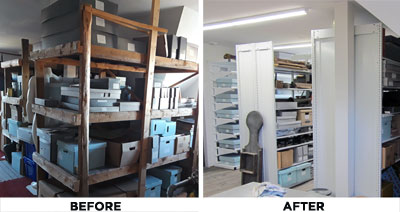Rehousing Collection Storage
 The Crow Wing County Historical Society collections have been accumulating since 1927 and are essential, abundant, and varied. They are in the County's former sheriff's residence and jail, listed on the National Register of Historic Places. They operate a historic house museum with displays of furniture, kitchen tools, and household items. The attached former jail was converted into a museum and our permanent exhibit. They also have a research library, which holds thousands of photographs, microfilms, books, and historical documents.
The Crow Wing County Historical Society collections have been accumulating since 1927 and are essential, abundant, and varied. They are in the County's former sheriff's residence and jail, listed on the National Register of Historic Places. They operate a historic house museum with displays of furniture, kitchen tools, and household items. The attached former jail was converted into a museum and our permanent exhibit. They also have a research library, which holds thousands of photographs, microfilms, books, and historical documents.
Consisting of tens of thousands of objects, roughly 30% of the collection is in storage. The current attic storage shelves are made of wood 2x6s, 2x4s, and interior grade plywood, and some repurposed rusty metal shelves. These shelves not only harm the collection through the off-gassing of chemicals, but they are also cumbersome and have caused structural damage to the building. Due to the size of our collection and our repurposed building, they have difficulty storing, organizing, and accessing stored items. This new shelving will result in the collection's physical preservation and ease access for display, research, and cataloging purposes.
Visit https://www.mnhs.org/about/leadership
Visit https://www.mnhs.org/preservation/legacy-grants/advisory-committee
$4,500,000 the first year and $6,500,000 the second year are for history programs and projects operated or conducted by or through local, county, regional, or other historical or cultural organizations or for activities to preserve significant historic and cultural resources. Funds are to be distributed through a competitive grant process. The Minnesota Historical Society must administer these funds using established grant mechanisms, with assistance from the advisory committee created under Laws 2009, chapter 172, article 4, section 2, subdivision 4, paragraph (b), item (ii).
Available upon request. grants@mnhs.org
Our projected short term impact was safe and ample storage for our artifacts. Upon entering our storage areas, it is easy to observe our success. The old bulky shelving and disorganized inaccessible storage is gone and replaced by professional, well-planned shelves in which objects are visible at a glance. The areas are easily physically navigated and every individual shelf is labeled for quick identification. A display space that had been taken over by storage was also able to be reclaimed for exhibits. We arrived at this result by hiring a storage professional and carefully planning the space according to our collection?s needs. Taking time to organize the collection while putting it on the new shelving was also a major contributing factor to our success.
Intermediately, we expected to have access to items for digital cataloging and exhibits, which has again been achieved through careful vendor selection and planning. It is clear that this project has allowed us to become more organized and has greatly increased staff knowledge of our collection, which will allow for future cataloging and exhibits. Each individual shelf has been labeled by category and number (see image Shelf Labels Final) which will be used for future location identification on paperwork and in our database. Objects have already been added to existing exhibits and a new exhibit on medical devices has been started in our reclaimed display space (see image Reclaimed Exhibit Space). We have also observed many themes that have been noted for future exhibits.
Long term impact is difficult to measure at this time, but I am confident that we will achieve success in maintaining our reputation as a public trust. We have already gained positive public exposure as a professional establishment through media exposure regarding the Legacy funded grant project. As we open to the public after COVID-19, I hope to provide tours of the storage area. This, in addition to the observance of new and updated displays, will help represent us as a professional yet fun, dynamic place to visit and learn.
Available upon request, grants@mnhs.org
